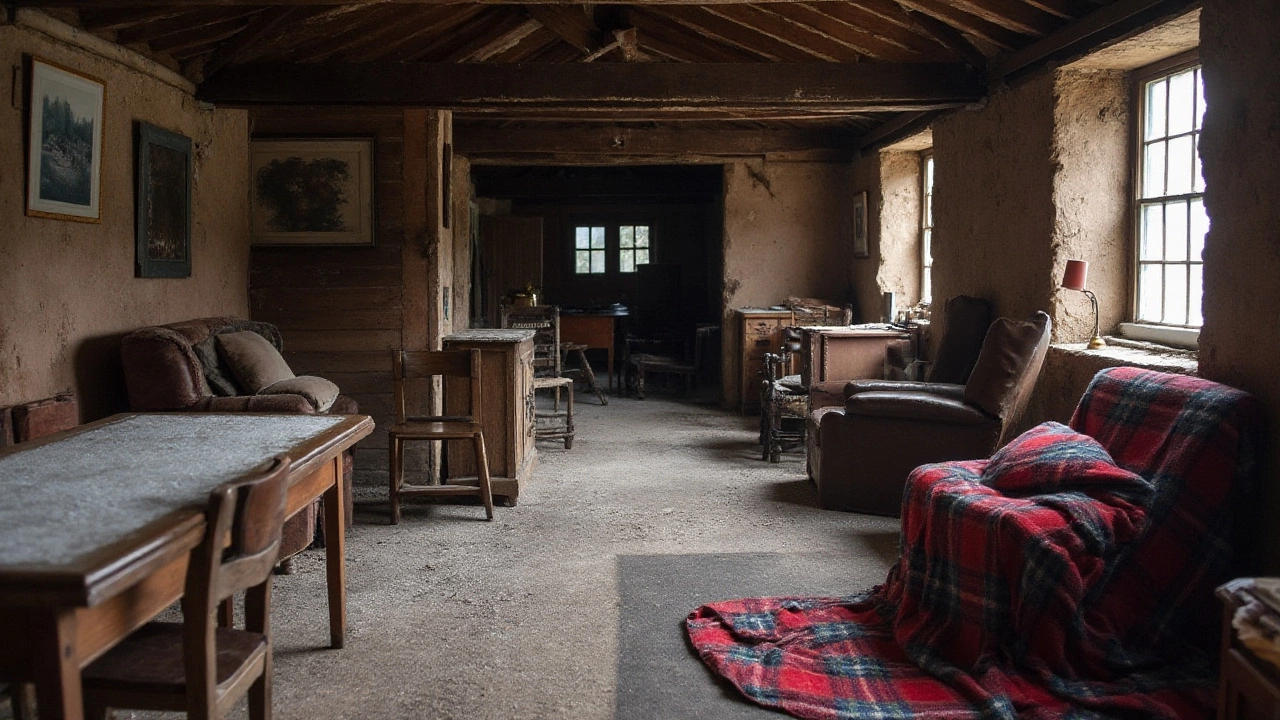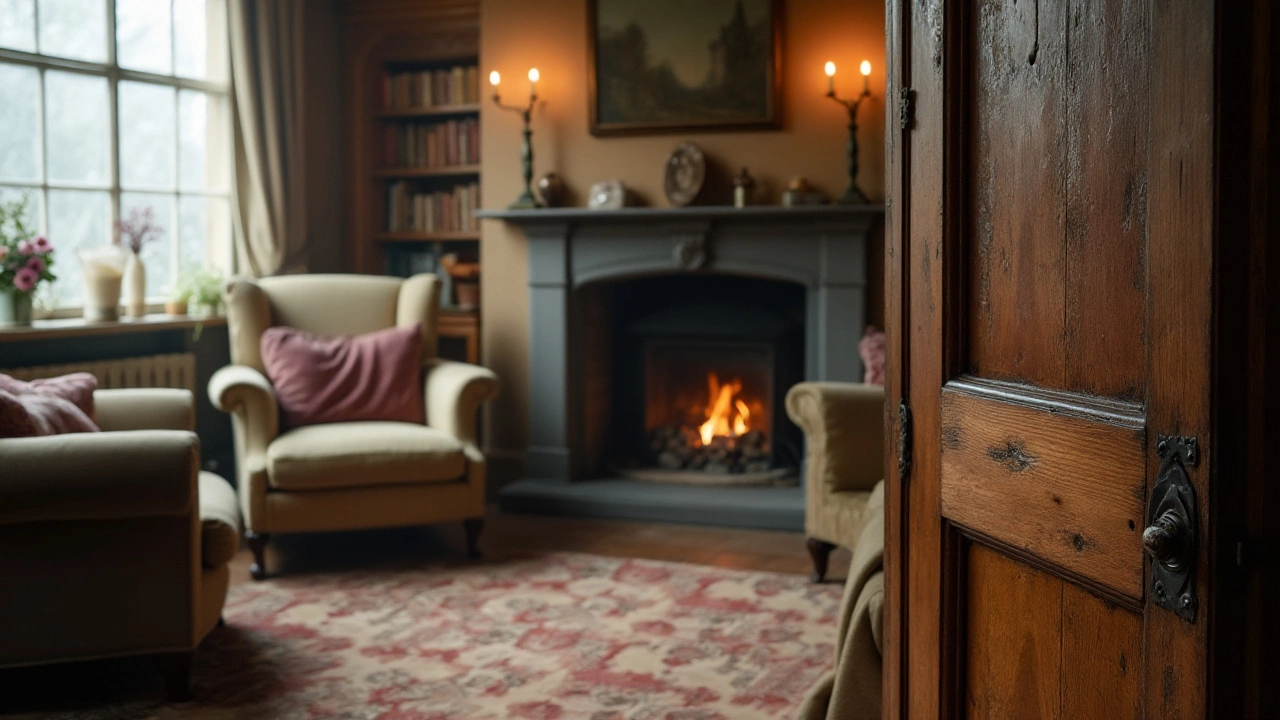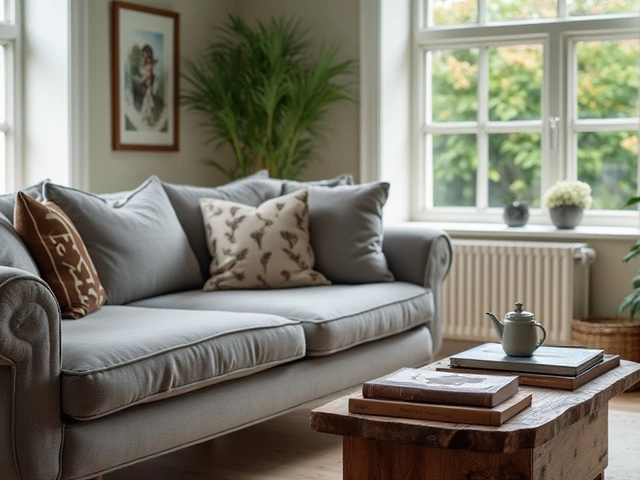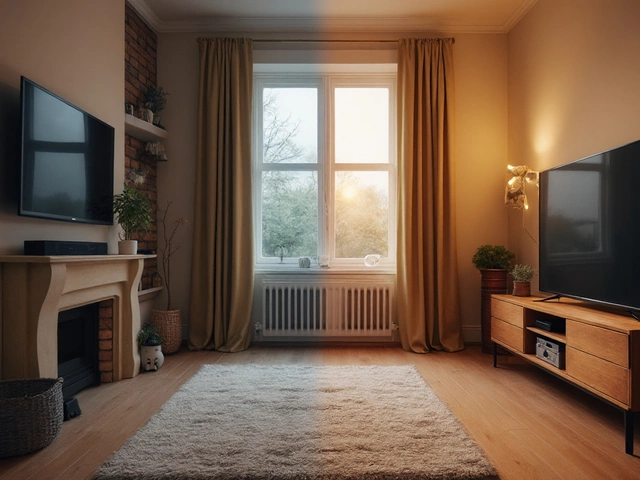When the chilly winds of December whip around the corners of your home, it's not just you that feels the bite; your furniture does too. Many of us tend to overlook the temperature impact on our furniture, especially those pieces stored away in attics or garages. But how exactly does the cold affect these items, and when is it too extreme?
Let's dive into the essentials of safeguarding your furniture from the freezing cold. We will look at how materials like wood and upholstery react to low temperatures and provide you with useful tips on preventing damage, so your furniture looks great and remains functional year-round.
- Understanding Temperature Effects on Furniture
- Signs of Cold Damage in Furniture
- Best Practices for Furniture Storage
- Materials and Their Temperature Sensitivity
- Protecting Furniture in Cold Climates
Understanding Temperature Effects on Furniture
Storage furniture isn't just about aesthetics; it represents an investment in both money and memories. When temperatures drop, many pieces, especially those made of natural materials, react in ways that could compromise their structure and appearance. Wood, for instance, responds significantly to climatic changes. As temperatures plummet and air retains less moisture, wood can shrink, leading to cracks or warping that can deform your prized furniture. This reaction primarily occurs because wood is an organic material with natural moisture content, so it's able to breathe in a way.
The elasticity of wood means that as it loses moisture in cold conditions, it contracts. This is not just a minor inconvenience but a significant factor in potential damage, particularly for antique or heirloom pieces. Cold air can cause adhesive joins in wood furniture to become brittle, leading to breakage in joints and frames. Upholstered furniture is not exempt from these adverse effects either. The cold impacts textile fibers, making them more susceptible to wear and tear, and potentially causing a loss of flexibility in padding materials.
Certain materials are more vulnerable than others. Genuine leather, for example, can crack and peel in cold, dry conditions, whereas synthetic leather might fare slightly better but still suffer from peeling over time. According to materials expert Dr. Carla Myers, "Understanding the properties of your furniture's material can help in choosing the right storage environment, reducing the risk of weather-induced damage." So, consulting with experts or doing adequate research on the material you're storing is crucial to prolong its life.
An interesting approach to evaluating furniture's susceptibility to cold would be referring to material-specific thermal stability tables. Here's a simplified example:
| Material | Temperature Sensitivity |
|---|---|
| Solid Wood | High |
| Metal | Low |
| Leather | Medium |
By recognizing the unique properties of each component, you'll appreciate the critical nature of their environment. Taking proactive steps now to understand and control these effects can prevent heartache later. While it might seem a bit cumbersome to consider, an ounce of prevention is certainly worth a pound of cure. This leads us to emphasize the importance of environmental control in storage areas, such as using insulated rooms or climate-controlled units that can maintain a stable environment for your precious pieces, keeping them safe from the degrading effects of intense cold.
Signs of Cold Damage in Furniture
Cold weather, especially when temperatures drop drastically, can be a silent enemy to your beloved furniture. It might seem that your storage furniture is safe from the wintry chill if it's tucked away inside, but cold finds its way in, impacting materials over time. One of the most common signs of cold damage is the appearance of cracks in wooden furniture. Wood naturally expands and contracts with temperature fluctuations, but when it loses moisture in the cold, it can shrink, leading to unsightly cracks. These aren't just cosmetic issues; they can weaken the integrity of the furniture over time.
Another red flag to watch out for is warping. Like cracking, warping occurs when the cold draws moisture out of the wood unevenly. This can cause sections of a piece to become misaligned, resulting in drawers that stubbornly stick or doors that won't fully close. Upholstered furniture isn't immune either. Cold can make the fabric brittle and more prone to tearing, while leather may stiffen and crack if not properly conditioned before the temperature dip. In metal components, such as hinges or leg supports, exposure to frigid conditions can lead to rust. Moisture in the air condensing on cold surfaces is a recipe for corrosion, gradually eating away at the metal over time.
It’s also worth considering the effect on adhesives and finishes. Many modern furniture pieces rely on glues and laminates that can become weak under low-temperature conditions, leading to delamination or joints that come loose. Varnishes and paints can also suffer, potentially chipping off and leaving the underlying material exposed and vulnerable. According to furniture conservation expert Jane Banks, "The effects of cold on furniture are often cumulative and can be devastating if not addressed promptly. Prevention is always better than restoration."
Identifying these problems early can save both time and money. Regularly inspect all storage furniture, particularly during the chilly months. Look for any changes in texture or color, especially in areas like basements or attics where temperature control might be less consistent. By being vigilant, you can catch and address issues before they require a professional hand and ensure your furniture survives winter in good health.

Best Practices for Furniture Storage
When tucking away your cherished belongings, especially those cherished heirlooms or newly acquired investment pieces, it's crucial to give some thought to how you'll handle furniture storage. Notably, low temperatures can wreak havoc on your furniture, potentially leading to cracking, warping, or even the degradation of upholstery materials. Ensuring your furniture remains in pristine condition requires a careful and considered approach, particularly where temperature regulation is concerned. Let's explore some effective strategies for maintaining your furniture’s integrity through the thick of winter.
To start, always assess the storage space conditions, specifically focusing on temperature and humidity levels. The ideal storage environment should be stable in these elements, avoiding extreme fluctuations that inherently stress materials like wood and leather. As a rule, an optimal temperature range lies between 50 to 80 degrees Fahrenheit, which protects against the wood fibers contracting in the cold. When possible, opting for climate-controlled storage ensures these variables remain balanced. According to Peter Henderson, a renowned conservator specialist,
"Preventative measures in storage can increase the lifespan of furniture by decades, preserving both form and function."These climate-controlled units, though potentially more expensive, offer the assurance that your valuable pieces won't suffer from the typical ailments cold weather imposes.
Packaging and positioning come next on the list of best practices. It’s beneficial to wrap your items in breathable materials like moving blankets or specialized fabric coverings. Avoid plastics since they can trap moisture, leading to mold and potential odorous problems. Moreover, make sure to store your furniture pieces off the floor if they're in a non-climate-controlled area. Sturdy pallets or blocks provide that necessary buffer between the chilly ground and your furniture. This step is especially crucial if there's any risk of water ingress due to melting snow or rainfall.
Furniture placement also deserves careful thought. Avoid placing heavy objects atop delicate surfaces to prevent unwanted dents or any toppling hazards. If you store disassembled items, such as tables or bed frames, keep screws and fittings taped to their respective parts or in clearly labeled bags to facilitate reassembly. The act of storing furniture doesn’t merely involve setting objects inside four walls; it’s about strategic positioning where your items are both accessible and safe from potential threats.
Finally, a regular inspection routine should be part of your storage furniture maintenance. Regular check-ups every few weeks allow you to spot potential issues like early signs of damage. If adjustments in positioning or coverings need to be done, you can swiftly manage them before they escalate. Making these inspections a part of your storage schedule guarantees not just safety, but peace of mind knowing your beloved pieces are cared for irrespective of the season’s chills.
Materials and Their Temperature Sensitivity
Furniture materials react differently to the cold, and understanding their vulnerabilities can help you protect your investments. Wood, one of the most common materials found in storage furniture, is particularly sensitive to temperature fluctuations. When wood is exposed to cold, dry air, it can contract, leading to cracks and splits. This is especially true for solid wood furniture, which can suffer noticeable separation at the joints. Veneer finishes may peel or bubble as the wood underneath adjusts to the temperature changes.
On the other hand, metal components in furniture, such as those in metal frames or fasteners, respond differently. Metals can contract in the cold, potentially causing structural parts to become loose or unstable. In contrast, upholstery materials like leather and fabric are susceptible to drying out and becoming brittle. Leather can crack if not conditioned properly, and certain fabrics can lose their flexibility, affecting the comfort and appearance of the piece.
Interestingly, some synthetic materials, commonly used in modern furniture designs, can also be vulnerable. Plastics can become brittle and prone to cracking in extremely low temperatures. This is a fact many overlook, thinking synthetic materials as universally durable, but cold climates can indeed play a significant role in their durability.
"Proper storage conditions are crucial for maintaining the integrity of your furniture," advises Dr. Emily Smith, an expert in material conservation. "Extreme temperatures can significantly shorten the lifespan of furniture if they are not appropriately managed."
In terms of data, it's noted that wood swells up to 1% to 2% across the grain with only a 10% increase in relative humidity, which can occur as furniture moves from cold, dry conditions to a more humid environment like a warming house. This can be illustrated in the sensitivity table below:
| Material | Cold Sensitivity |
|---|---|
| Wood | Cracking, joint separation |
| Metal | Contraction, potential instability |
| Leather | Cracking, drying |
| Fabric | Loss of flexibility |
| Plastic | Brittleness, cracking |
Having a solid grasp of these temperature effects can assist you in taking preventive measures. Keep these points in mind when preparing your furniture for winter storage; it could be as simple as adding humidifiers to a room or using covers that help buffer against temperature changes. Understanding storage furniture needs during the cold season can save you time, money, and the heartache of damaged beloved pieces.

Protecting Furniture in Cold Climates
As temperatures drop, taking steps to protect your storage furniture becomes crucial. Cold climates can wreak havoc on various types of materials, so understanding these effects is the first step in preventing damage. Wooden and upholstered furniture are particularly vulnerable. Wood can contract and expand, leading to cracks or warping, while fabrics may become brittle or fade in extreme cold. To avoid these issues, it's vital to maintain a stable environment where your furniture is stored. A well-insulated space is ideal, but not everyone has that luxury. Here are some strategies that you can apply to safeguard your belongings.
One effective solution is to use furniture covers, which provide an essential barrier against the cold. These covers should be breathable to prevent moisture build-up that could lead to mold. Wrapping pieces in heavy blankets or specially designed furniture pads can also add an additional layer of protection. It's worth noting that some furniture pads designed for winter use have insulating properties that help to keep the temperature constant.
Investing in a dehumidifier or heater for your storage area can be a smart move, especially when temperatures plunge. These devices help maintain a moderate temperature, preventing the air from becoming too dry or too damp. According to the British Furniture Manufacturers association, "keeping furniture in environments where the temperature remains between 50-75°F (10-24°C) and humidity is around 40-55% can significantly prolong the life of the furniture". It's a sound piece of advice that can help preserve your cherished items.
For those who live in particularly cold climates, it's beneficial to regularly check on stored furniture. Look for signs of damage such as cracked wood, signs of condensation, or mildew. Being proactive allows you to address small problems before they become big headaches. Regularly moving furniture, even slightly, helps avoid pressure points and ensures all pieces are exposed to uniform conditions.
An emerging trend is the use of smart storage systems that integrate climate control technology. These are expensive but effective solutions for furniture storage, as they allow users to monitor and adjust conditions using digital devices. Consider this option if you store high-value items or antiques. The upfront investment might be worthwhile given the protection it offers. Navigating the challenges of storing furniture in the cold is all about balance and preparation. From covering to climate control, these methods serve as valuable tools in maintaining the integrity of your precious furniture.



